Intel NUC13 Extreme Raptor Canyon Review: Sizzling SFF Performance Powerhouse
by Ganesh T S on December 14, 2022 8:00 AM EST- Posted in
- Systems
- Intel
- NUC
- Raptor Lake
- Raptor Canyon
- NUC13
- NUC Extreme
System Performance: Miscellaneous Workloads
Standardized benchmarks such as UL's PCMark 10 and BAPCo's SYSmark take a holistic view of the system and process a wide range of workloads to arrive at a single score. Some systems are required to excel at specific tasks - so it is often helpful to see how a computer performs in specific scenarios such as rendering, transcoding, JavaScript execution (web browsing), etc. This section presents focused benchmark numbers for specific application scenarios.
3D Rendering - CINEBENCH R23
We use CINEBENCH R23 for 3D rendering evaluation. R23 provides two benchmark modes - single threaded and multi-threaded. Evaluation of different PC configurations in both supported modes provided us the following results.
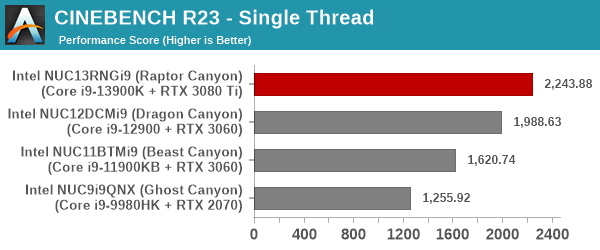
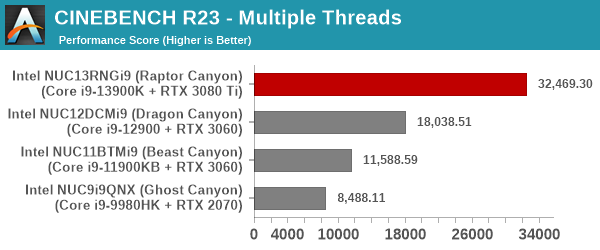
The Raptor Canyon NUC's Core i9-13900K has a huge core-count advantage as well as a much higher PL1 / TDP at its disposal. So, it comes as no surprise that both the single- and multi-threaded benchmarks are dominated by it.
Transcoding: Handbrake 1.5.1
Handbrake is one of the most user-friendly open source transcoding front-ends in the market. It allows users to opt for either software-based higher quality processing or hardware-based fast processing in their transcoding jobs. Our new test suite uses the 'Tears of Steel' 4K AVC video as input and transcodes it with a quality setting of 19 to create a 720p AVC stream and a 1080p HEVC stream.
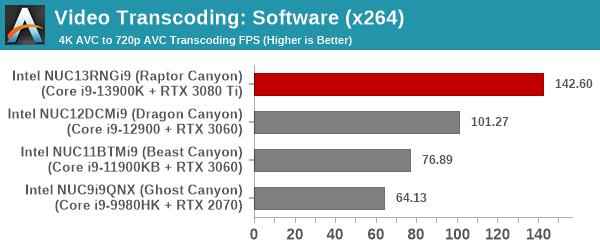
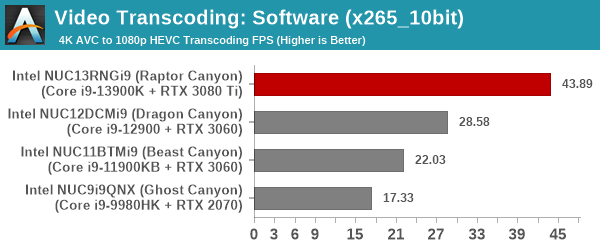
Software transcoding is well-served by the large number of cores as well as high clock-speeds / power budget. No surprises are in store in the x264 / x265 benchmarks.

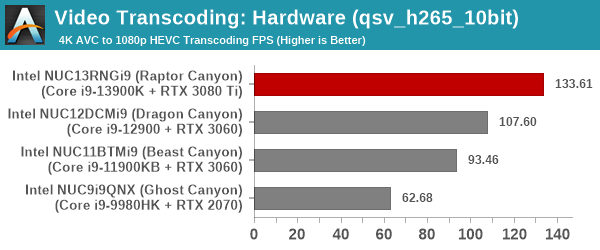
The Raptor Canyon NUC allows use of the QuickSync transcoding engine in the Intel UHD 770 iGPU even without any display connected to it. Higher power budgets allow the iGPU to operate with higher throughput in the Raptor Canyon NUC compared to the Dragon Canyon NUC, even though they both have essentially the same iGPU architecture.
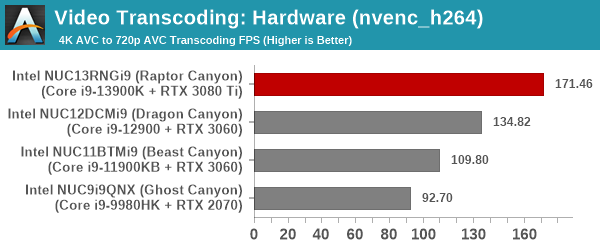

The 'nvenc' transcoding rates are graphed separately and can't be compared with the QuickSync results since the quality and size of the resultant files are different. However, within themselves, we see the RTX 3080 Ti being better than the RTX 3060, which is in turn better than the RTX 2070 - all as expected.
Archiving: 7-Zip 21.7
The 7-Zip benchmark is carried over from our previous test suite with an update to the latest version of the open source compression / decompression software.
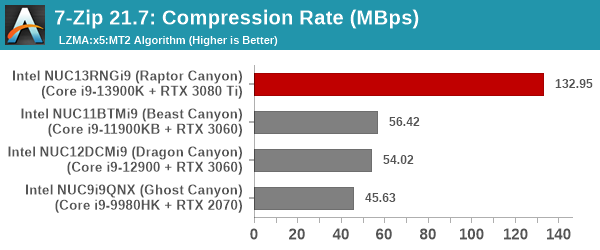

7-Zip performance scales well with the number of cores, as well as the clock rate. This is clearly seen here with the Raptor Canyon NUC ending up with a significant lead over other systems.
Web Browsing: JetStream, Speedometer, and Principled Technologies WebXPRT4
Web browser-based workloads have emerged as a major component of the typical home and business PC usage scenarios. For headless systems, many applications based on JavaScript are becoming relevant too. In order to evaluate systems for their JavaScript execution efficiency, we are carrying over the browser-focused benchmarks from the WebKit developers used in our notebook reviews. Hosted at BrowserBench, JetStream 2.0 benchmarks JavaScript and WebAssembly performance, while Speedometer measures web application responsiveness.
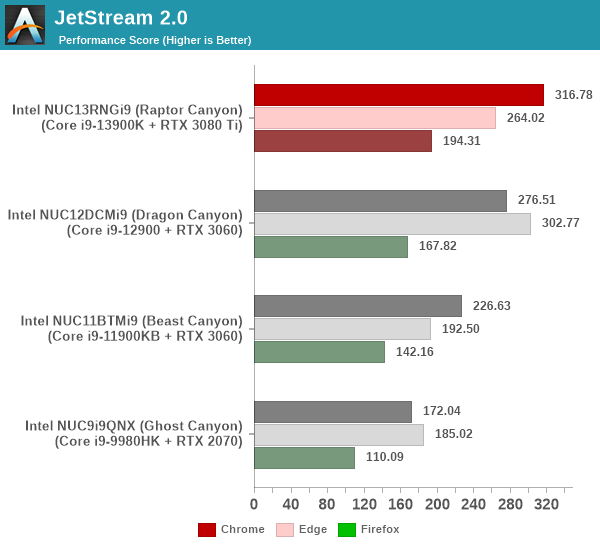
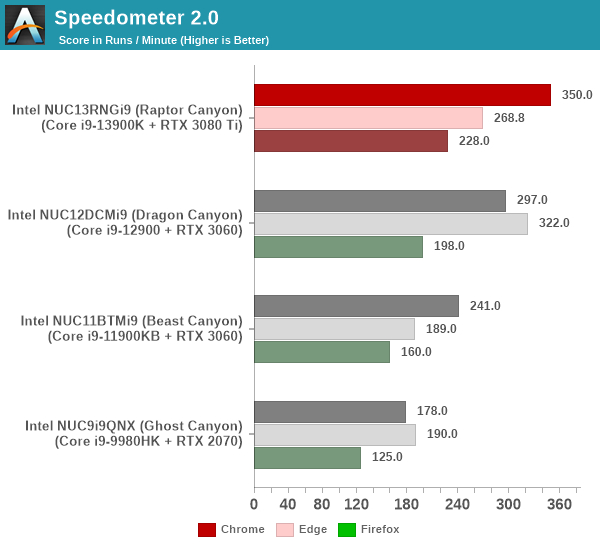
From a real-life workload perspective, we also process WebXPRT4 from Principled Technologies. WebXPRT4 benchmarks the performance of some popular JavaScript libraries that are widely used in websites.

While the performance of Chrome in all three benchmarks is as expected - the Raptor Canyon NUC performing best, with each NUC generation being better than the previous one, Microsoft Edge surprisingly performs better on the Dragon Canyon NUC compared to Raptor Canyon.
Application Startup: GIMP 2.10.30
A new addition to our systems test suite is AppTimer - a benchmark that loads up a program and determines how long it takes for it to accept user inputs. We use GIMP 2.10.30 with a 50MB multi-layered xcf file as input. What we test here is the first run as well as the cached run - normally on the first time a user loads the GIMP package from a fresh install, the system has to configure a few dozen files that remain optimized on subsequent opening. For our test we delete those configured optimized files in order to force a 'fresh load' every second time the software is run.
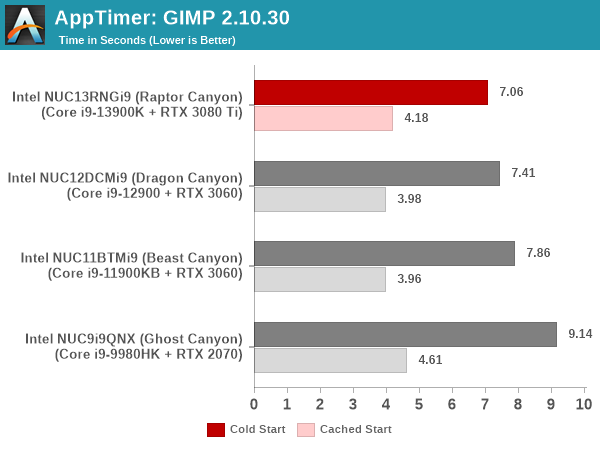
As it turns out, GIMP does optimizations for every CPU thread in the system, which requires that higher thread-count processors take a lot longer to run. So the test runs quick on systems with fewer threads, however fast cores are also needed. The net result is that the Raptor Canyon's cold start times are the best. However, with caching involved, the lower thread-count systems turn out to be slightly better.










27 Comments
View All Comments
PeachNCream - Wednesday, December 14, 2022 - link
There is nothing to make this PC stand out among other SFF computers and a few key downsides versus ITX such as limited upgrade options for the future. If its going to be that big, it should offer things other similar desktops do not. Color me unimpressed.Samus - Thursday, December 15, 2022 - link
That's my chief complaint. There isn't any advantage here over a standard ITX system.rmari - Wednesday, December 14, 2022 - link
8 Liters = 2.1 gallons in size. Picture 2 1-gallon milk bottles side to side.That is a large size for an NUC. This is much larger than the X-Box Series X,
which is 6.7 Liters in size. So is this a NUC? No way.
escksu - Wednesday, December 14, 2022 - link
Sorry Intel, I have to say this product fails as NUC. One of the most unique feature about NUC is the size. This is just way too big. As others have mentioned, it is entirely possible to go smaller using standard itx board and it cost less.darkmatter236 - Wednesday, December 14, 2022 - link
I kind of like it actually. Good cooling for the GPU, good cooling for the CPU with an option to add another 92 mm fan for the CPU cooler.It's not small, but it's not big either since it's under 20 liters. Good performance, fairly quiet, and ok size.
thestryker - Thursday, December 15, 2022 - link
Appreciate the thorough review as always on the NUCs. Not enough places seem to get into them and put out useful data.I understand why some might be disappointed by the size vs what else you can get on the market. I don't particularly mind it myself as they seem to be trying new things out. The biggest issue I have with it is the same issue as with the last two: you're paying a very high premium price for something you could do yourself for a fair bit less while getting better peak performance due to not being limited by SODIMMs.
TheinsanegamerN - Monday, December 19, 2022 - link
"they're trying things out"That's a pretty hard cop out for "they took a micro ATX case and made it proprietary".
thestryker - Tuesday, December 20, 2022 - link
No it's an acknowledgement of the fact that they've had 4 NUC Extreme systems and 3 dramatically different designs and this probably isn't the last.DannyH246 - Thursday, December 15, 2022 - link
Oh cool i didn't realize Anand reviewed mini personal home heaters.d40ppatt - Thursday, December 15, 2022 - link
Does Anandtech still do GPU reviews?